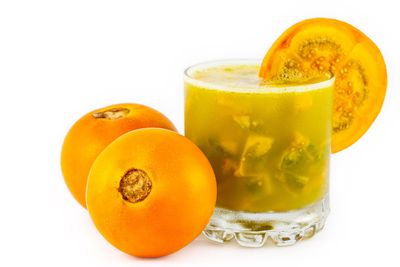Information About Using Naranjilla
If you are fluent in Spanish, then you recognize that ‘naranjilla’ means little orange. This nomenclature is somewhat flawed, however, in that naranjilla is not related in any way to citrus. Instead, naranjilla (Solanum quitoense) is related to the eggplant and tomato; in fact, the fruit looks very similar to a tomatillo on the inside. The outside of the fruit is covered with sticky hairs. As the fruit ripens, it turns from a bright green to orange. Once the fruit is orange, it is ripe and ready to pick. Ripe naranjilla’s little hairs are rubbed off and the fruit is washed and then it is ready to eat.
How to Use Naranjilla
The fruit can be eaten fresh but the skin is a bit tough, so many people simply cut it in half and then squeeze the juice into their mouths and discard the rest. The flavor is intense, tangy, and citrusy rather like a combination of a lemon and pineapple. With its flavor profile, it’s no wonder that the most popular way of eating naranjilla is to juice it. It makes excellent juice. To make juice, the hairs are rubbed off and the fruit washed. The fruit is then cut in half and the pulp squeezed into a blender. The resulting green juice is then strained, sweetened, and served over ice. Naranjilla juice is also produced commercially and then canned or frozen. Other naranjilla fruit uses include the making of sherbet, a combination of corn syrup, sugar, water, lime juice, and naranjilla juice that is partially frozen and then beaten to a froth and refrozen. Naranjilla pulp, including seeds, is also added to ice cream mix or made into a sauce, baked into pie, or used in other desserts. The shells are stuffed with a combination of banana and other ingredients and then baked.
